
This site celebrates the life and work of sculptor John
Cassidy (1860 - 1939).
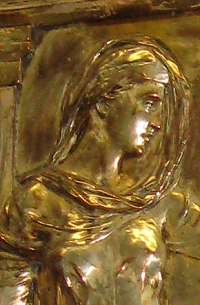
One of the joys of making this website is that we have been contacted by relatives of John Cassidy, of which there are a considerable number in the United States, descended from his brothers who, like many of their countrymen, emigrated from Ireland in search of a better life.
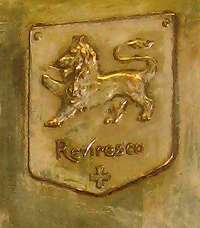
We have found few written records of Cassidy's works from his own time, but family members have sent us a list made, possibly from memory, by John Cassidy's assistant, Edith Brown (if anyone knows more about this lady and her career, please get in touch.)
On the list are some intriguing references to works not mentioned in our other sources, including 'Rishton - war memorial for the conservative club.'
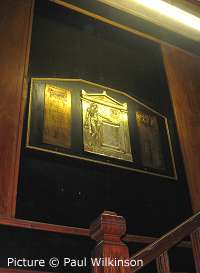
There is an excellent website for and about the town of Rishton, run by Paul Wilkinson, who has very kindly visited the Club, which still flourishes (the memorial is inside the private building) and taken these pictures for us, as well as supplying most of the information. As the picture above shows, the memorial is located high on the wall of a stair-well, making photography difficult.
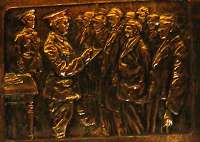
The relief on the right-hand plaque: recruiting a 'Pals' regiment perhaps?
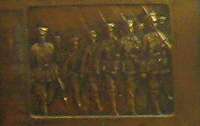
The left-hand relief: marching off to war.
The names:
Centre Panel:
Harry Bailey
Arthur Banks
Arthur Conway
Enoch Cowell
Israel Edge
Leonard Edge
William Hulme
Thomas Knowles
Arthur Newman
Albert E. Mercer
Fred Proctor
Ernest Ramsbottom
Robert Walmsley
Left and right panels:
John H. Airey
Alfred Ayres
Harry Bateson
Peter Baxendale
Peter Bibby
Joseph A. Boardman
Harold M. Boardman
Harold W. Bower
Albert Cheetham
Richard Colley
James Cornall
Thomas Crabtree
John Croasdale
Frank Cunliffe
John Day
Richard Dobson
Arthur Dove
Francis Duckworth
Robert Duckworth
Thomas Duckworth
Starkie Duckworth
James Duxbury
George Eddleston
Roger Edge
Joseph Fletcher
William Fletcher
William E. Gilder
Ernest Green
John Grimshaw
Douglas H. Hacking
Fred Haworth
Thomas E. Haworth
George H. Haworth
George H. Hodkinson
Thomas H. Hornby
Thomas Hulme
George Hulme
John Johnson
William Jolly
George Kitchener
William R. Knowles
Frank Knowles
Henry Knowles
William R. Knowles
John W. Lancaster
William Lewis
Jacob Looms
Joseph Makinson
Robert Massey
John McIntosh
John Mellett
Robert B. Nixon
Thomas E. Noble
Joseph Norman
Harold Parker
Richard Pate
John Pilkington
William Pilkington
James Proctor
Arthur Ramsbottom
Samuel Ridgway
Robinson Robinson
Alfred Sharples
Mathew Smith
Clarence Smith
Luther Smith
William Smith
Alfred Trengrove
Phillip Thomas
John E. Wade
John T. Walsh
John Waterhouse
Joseph Watson
John E. Whittaker
Edgar Wilding
James Wilkinson
Rishton Conservative Club War Memorial
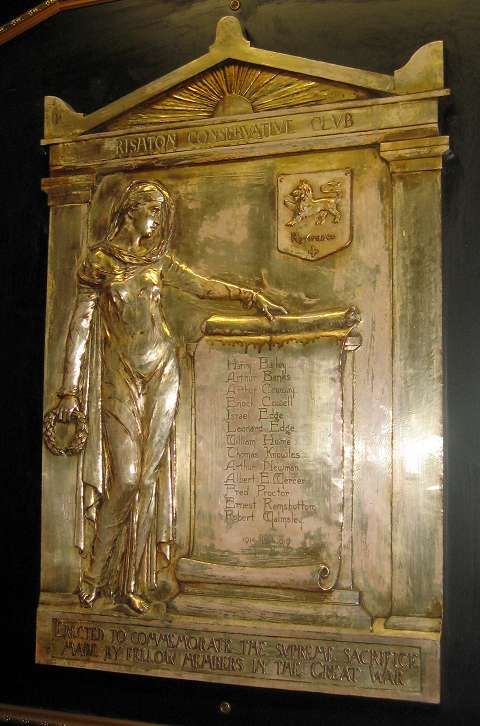
Rishton is a small town in the Hyndburn district of Lancashire, England, about two miles west of Clayton-le-Moors (which has a John Cassidy War memorial) and two miles east of Blackburn. It has a rail station on the East Lancashire Line.
Rishton has its own public Centotaph, but the work which concerns us is in the town's Conservative Club. Such club buildings, with their membership often centred around political parties - Conservative, Labour or Liberal - can be found in many English towns and villages. They mostly appeared in the nineteenth century, formed as a way promoting their political viewpoint and providing social and sporting venues for their members. To use the club facilities, one has to pay a subscription, and be governed by the club rules of behaviour. It is said that in working-class towns with strong membership of the Labour Party, one often finds a flourishing Conservative Club.
The memorial is one of thousands of these smaller memorials to be found in clubs, workplaces, churches, colleges etc. all over Britain. Many (but not yet this one) are listed in the National Inventory of War Memorials.
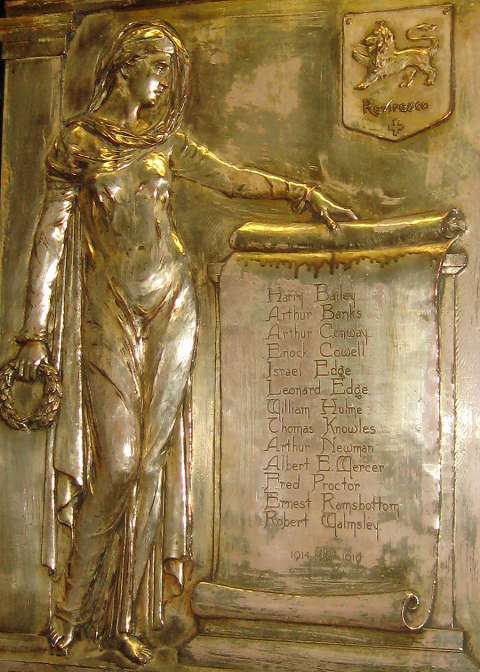
The memorial consists of three parts. The central plaque, which has been kept highly polished, of a female figure holding a wreath, symbolising peace, holding a scroll listing 13 names in (almost) alphabetical order, above the dates 1914-19. In the top right is a shield with a lion and a cross and the word 'Reviresco' which means 'I grow (or flourish) again.' This is the crest of the town of Rishton. The pediment carries the words:
RISHTON CONSERVATIVE CLUB
and at the base:
ERECTED TO COMMEMORATE THE
SUPREME SACRIFICE MADE BY FELLOW MEMBERS IN THE GREAT WAR

Two other plaques, one each side of the central plaque, and each with a typical Cassidy relief of a group of soldiers, list 89 other names, with surnames A to J on the left one and J to W on the right. How these people differ from those in the central panel remains to be explained - Rishton's public war memorial carries 185 World War I names, many, if not all, of which also appear on the club list.
The most likely theory is perhaps that only the men in the centre panel were Club members, and it was decided to commemorate other men of Rishton on the other two. The right-hand plaque is signed 'John Cassidy Fecit 1920' in Cassidy's usual manner - this was before the construction of the town's memorial, which was unveiled in 1923.
Rishton Conservative Club
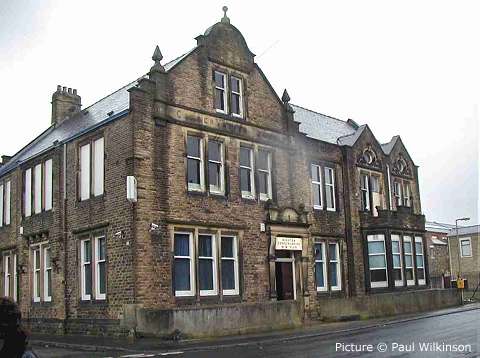
The Rishton Conservative Club was formed was in 1873; the current building, in Cliff Street, was designed by J.C. Howard Sandbach and J. Parker, and officially opened on the 16th June 1899 by the conservative candidate at the time, Mr Edward Michaels.
In addition to the club proper which consists of a reading room, library, two billiard rooms, two smoke rooms, committee room, card room, Stewards room and other offices, there is also a concert hall and lecture hall on the ground floor which is capable of seating up to 300 people. A bowling green occupies a large part of the property, which consists of almost 3,000 square yards.
Links and References:
www.rishton.net
Rishton Conservative Club War Memorial by Paul Wilkinson
East Lancashire War Memorials by Susan Eldridge
Greater Accrington Roll of Honour 1914-1919.
Rishton in Wikipedia
Commonwealth War Graves Commission
Written by Charlie Hulme May 2009. Pictures by Paul Wilkinson